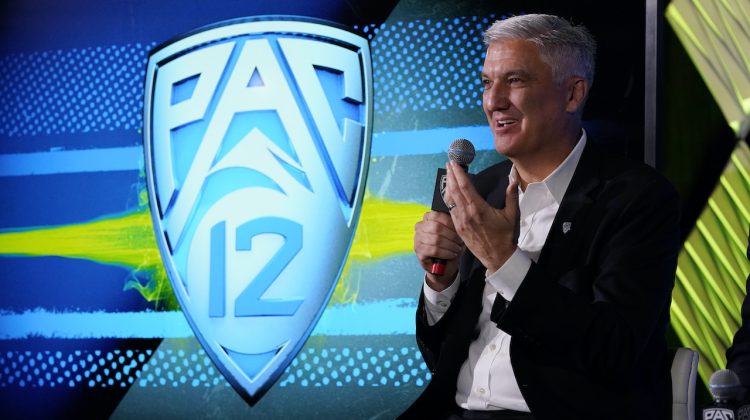Pac-12 fans and Hotline readers were caught by surprise 361 days ago when news broke that the Los Angeles schools were leaving for the Big Ten in the summer of 2024, sparking an existential crisis for the century-old conference.
We don’t want you to be surprised by the endgame.
For that reason, the Hotline has spent the past year addressing such varied topics as the role of the Pac-12 Networks, the value of Saturday night kickoffs, possible partnerships with the Big 12 and ACC, the benefits of going all-in with Amazon, the impact of economic conditions, the San Diego State imperative, the SMU calculation and the risk of delay.
Nor have we ignored the ongoing possibility of an extinction event: Commissioner George Kliavkoff presents a suboptimal media deal to his presidents and an exodus begins.
But there are other potential outcomes to this highly fluid situation — scenarios that we have not covered in depth on the Hotline. Six are addressed below. They might seem unlikely or even extreme, but that’s precisely the point: No endgame should be ignored until there’s a deal.
After all, nobody expected a crisis that began on June 30, 2022 would be unresolved on June 26, 2023?
Scenario I: The X factor
Summary: One facet of the media rights deal is completely unexpected (despite our best efforts to cover the full sweep of possibilities).
The case: For months, the trail of breadcrumbs has suggested the Pac-12 will sign a medium-length media rights deal (five to seven years) with Apple or Amazon, ESPN and possibly Fox as the partners and a valuation within close range of the Big 12 ($31.7 million per school per year).
But the conference has done a masterful job preventing leaks, and that lack of information leaves us with an overwhelming sense that there’s an unreported element — something unprecedented in the history of collegiate media rights deals.
For example, could the number of games on streaming increase over time as that platform becomes mainstream?
Could there be some sort of flex scheduling piece?
Could the Pac-12 join arms with NBC or CBS?
We are merely guessing, but don’t be surprised if one aspect of the deal is an eye-opener.
Likelihood: 60 percent
Scenario II: Standing on 10
Summary: The 10 remaining schools decide not to expand.
The case: The Hotline has plunged into the issue of game inventory numerous times during the saga, but here’s an eight-word recap: More teams equals more games equals more money.
As a 10-team conference, the Pac-12 would have approximately 65 home football games per year to license to its media partners. As a 12-team league, it would control roughly 78 games annually. And each game is worth several million dollars.
What’s more, the additional inventory would allow the Pac-12 to more easily fill the Thursday and Friday night windows that carry value for the networks.
But what if Kliavkoff crafts a deal that places the Pac-12 in the same valuation range as the Big 12 schools without the added inventory? In that case, the presidents might favor hunkering down with 10.
Likelihood: 20 percent
Scenario III: That’s a wrap
Summary: The Pac-12 quietly agreed to a media rights deal months ago.
The case: Recall that flurry of forecasts from the university presidents in February and March that suggested a deal was imminent. Three months later, it appears they grossly misread the situation.
But what if the presidents were right? What if Kliavkoff accepted final bids from the networks during that early-spring window and settled on a preferred offer, but he couldn’t cross the finish line with a formal contract because of delays with the negotiating partners?
In other words: The framework for a deal has been in place for months.
That would explain why the presidents took the time to settle on the language in the grant-of-rights agreement, which they plan to sign as soon as the formal offer is presented.
After all, they’re running multi-billion-dollar campuses and would never bother with the grant-of-rights piece if Kliavkoff were scrambling to rustle up offers.
Likelihood: 15 percent
Scenario IV: All-in with Mickey
Summary: The Pac-12 agrees to license all football, men’s and women’s basketball and Olympic sports content to Disney, the parent company of the ESPN networks, ABC and the Hulu streaming platform.
The case: For all the speculation about ESPN not wanting the Pac-12 inventory — or preferring a small package of games — what if the opposite is true?
Disney would have the option to place a handful of games on ABC; it would retain the valuable 7:30 p.m. Saturday window; and it would have a huge pool of content for ESPN+ and any other company-owned streaming platforms.
(Remember, the primary ESPN network will move to streaming in a few years and become the warehouse for the vast majority of Disney’s college football inventory.)
Additionally, an all-in deal would give ESPN the licensing rights to non-conference showdowns played on Pac-12 campuses, including Oregon-Oklahoma State (2025), Arizona State-Texas A&M (2027), Washington-Michigan (2028), Colorado-Florida (2029) and Utah-LSU (2031).
The issue here, of course, is the price point. The conference might desire a comprehensive deal with Disney, but would the valuation figure be acceptable to the cash-starved schools?
Likelihood: 10 percent
Scenario V: Strength in numbers
Summary: The Pac-12 decides to add four teams, not two.
The case: When it comes to the membership issue, much of the media focus has been on two outcomes: Standing on 10 or adding San Diego State and SMU. There has been zero attention (either informed or wildly speculative) placed on adding four schools.
Once again, we turn to the inventory calculation. With 14 members, the conference would control approximately 90 games each season — or 25 more than if it does not expand.
Which schools are in line to join the Aztecs and Mustangs?
The Hotline could make a case for Rice or Tulane, which easily clear the academic bar and would provide access to the Houston and New Orleans markets, respectively. But it’s not a strong one.
Likelihood: 1 percent
Scenario VI: Hitting pause
Summary: Instead of finalizing a media rights deal this summer, the Pac-12 delays until the winter.
The case: There isn’t one, at least in the known universe. But the Hotline loves the alternate version, where this outcome warrants a mention.
Given that the next media rights cycle doesn’t start until the summer of 2024, there are no contractual or structural impediments to delaying the process through the upcoming football season.
Why bother mentioning this seemingly outlandish scenario? Because the near-term outlook for Pac-12 football — the 2023 season — is extremely bright: The conference should have five or six teams in the preseason AP poll and is loaded with Heisman Trophy candidates and high-profile coaches.
This could be the best season for television ratings in conference history, and those ratings, in theory, could drive up the price of the content. (And don’t forget, the Pac-12 is the only Power Five conference with football inventory available until the 2030s.)
Obviously, the uncertainty that accompanied another delay would leave the schools vulnerable to poaching, so this strategy would carry massive risk — the ultimate example of betting on yourself.
But goodness, it would be fascinating.
Likelihood: 0.1 percent
*** Send suggestions, comments and tips (confidentiality guaranteed) to pac12hotline@bayareanewsgroup.com or call 408-920-5716
*** Follow me on Twitter: @WilnerHotline
*** Pac-12 Hotline is not endorsed or sponsored by the Pac-12 Conference, and the views expressed herein do not necessarily reflect the views of the Conference.
Related posts:

Southern California quarterback Caleb Williams (AP Photo/Marcio Jose Sanchez)
Pac-12 need-to-knows: It’s not all about Utah and Oregon, new QBs in the spotlight, eyeballs matter and more Wilner Hotline – Best of the West: Washington soars, BYU slides and the Pac-12 dominates the Mountain West
Wilner Hotline – Best of the West: Washington soars, BYU slides and the Pac-12 dominates the Mountain West  Wilner Hotline: Breaking down the Pac-12 stretch-run schedules, a ratings gem, Homecoming dates and more
Wilner Hotline: Breaking down the Pac-12 stretch-run schedules, a ratings gem, Homecoming dates and more 
(AP Photo/Ralph Freso, File)
Pac-12 picks: Utah, USC cover on the road while Arizona meets the moment and OSU rolls on
